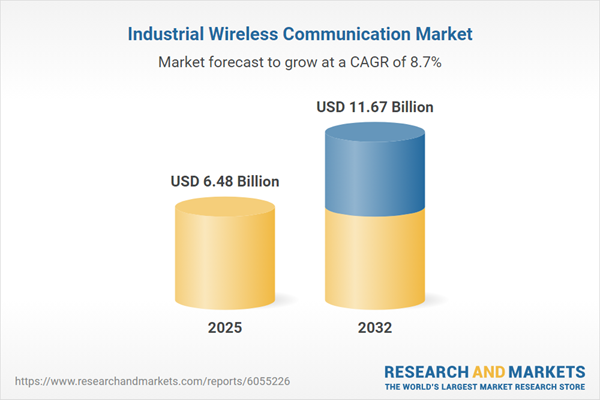Speak directly to the analyst to clarify any post sales queries you may have.
Industrial wireless communication is rapidly becoming integral to operational strategies in manufacturing and infrastructure, offering organizations the connectivity needed to thrive amid digital transformation. As industrial networks evolve, decision-makers face increasing pressure to address technology convergence, regulatory shifts, and supply chain uncertainties.
Market Snapshot: Industrial Wireless Communication Market Growth
The global industrial wireless communication market is experiencing steady growth, advancing from USD 6.00 billion in 2024 to USD 6.48 billion in 2025, and projected to expand at a CAGR of 8.67% to reach USD 11.67 billion by 2032. Demand is driven by the widespread deployment of wireless connectivity across manufacturing, utilities, and logistics, as organizations adopt digital technologies to enhance productivity, flexibility, and safety. A convergence of intelligent devices, automation initiatives, and evolving security standards is defining a new era for industrial connectivity.
Scope & Segmentation Overview
- Component Scope: Hardware such as antennas, controllers, routers, and switches; services including installation, integration, support, maintenance; software covering network management and security.
- Technology Types: LPWAN (LoRaWAN, Sigfox), WLAN (802.11a, 802.11b), WPAN solutions (Bluetooth, Zigbee including home automation and smart energy profiles).
- Grade Segmentation: Solutions aligned by basic, high, intermediate, and ultra-reliable grades, tailoring resilience to distinct operational and safety needs.
- Application Areas: Use cases include agricultural machinery factories, automobile factories, construction machinery facilities, energy and utilities, electronics (consumer appliances, industrial), motorcycle and three-wheeler factories.
- Regional Coverage: Americas (US, Canada, Mexico, Brazil, Argentina, Chile, Colombia, Peru), Europe, Middle East & Africa (including UK, Germany, France, Russia, Italy, Spain, Netherlands, Sweden, Poland, Switzerland, UAE, Saudi Arabia, Qatar, Turkey, Israel, South Africa, Nigeria, Egypt, Kenya), and Asia-Pacific (China, India, Japan, Australia, South Korea, Indonesia, Thailand, Malaysia, Singapore, Taiwan).
- Company Analysis: Leading players include ABB Ltd., Advantech, Analog Devices, Belden, Bosch Rexroth, Cisco Systems, Commscope, Emerson Electric, Ericsson, General Electric, HPE, Honeywell International, Huawei, IBM, Johnson Controls, Mitsubishi Electric, Netgear, Nokia, Panasonic, PTC, Qualcomm Technologies, Rockwell Automation, Schneider Electric, Siemens, Texas Instruments, and ZTE Corporation.
Key Takeaways for Senior Decision-Makers
- Technology convergence is accelerating, requiring seamless integration of established and next-generation wireless protocols to support real-time control and data processing.
- Edge computing investments enable distributed analytics, reducing network latency and empowering automated decision-making near the source of data.
- Security remains a top priority, with organizations advancing threat monitoring and encryption to protect critical operations from evolving cyber risks.
- Sustainability influences network planning; firms increasingly prioritize energy-efficient nodes and power management to align wireless deployments with environmental objectives.
- Manufacturers and utilities are adjusting procurement cycles and technology standards, streamlining logistics, and enhancing collaboration between sourcing and engineering teams for improved adaptability.
Impact of US Tariffs and Global Supply Dynamics
Forthcoming United States tariffs will affect the cost structure of hardware and networking products, prompting a reassessment of supplier relationships and procurement terms. Companies are exploring supplier diversification, regional manufacturing, and nearshoring strategies to sustain supply continuity and protect margins. These changes amplify the necessity of collaborative planning among procurement and operations, particularly in a tariff-sensitive environment where contract flexibility and long-term sourcing strategies become increasingly strategic.
Research Methodology & Data Sources
This analysis reflects extensive primary research via interviews with industry leaders, network architects, and procurement experts, and in-depth technical discussions with solution providers. Secondary research includes examination of industry publications, regulatory documents, and market databases. Cross-validation and analytical frameworks ensure an objective, comprehensive portrait of market trends and dynamics.
Why This Report Matters
- Empowers leaders to make informed connectivity investments, optimizing operations through data-driven network architecture decisions.
- Clarifies the practical impact of regulatory and trade developments, helping organizations implement proactive supply chain strategies.
- Enables data-backed benchmarking against peer organizations, guiding technology roadmaps and long-term planning across global markets.
Conclusion
Industrial wireless communication is reshaping operational approaches throughout modern enterprises. Senior decision-makers equipped with clear insights and actionable strategies are better prepared to navigate complexity and unlock new connectivity-driven value.
Table of Contents
3. Executive Summary
4. Market Overview
7. Cumulative Impact of Artificial Intelligence 2025
Companies Mentioned
The companies profiled in this Industrial Wireless Communication market report include:- ABB Ltd.
- Advantech Co., Ltd.
- Analog Devices, Inc.
- Belden Inc.
- Bosch Rexroth AG
- Cisco Systems, Inc.
- Commscope Holding Company, Inc.
- Emerson Electric Co.
- Ericsson AB
- General Electric Company
- Hewlett Packard Enterprise Company
- Honeywell International Inc.
- Huawei Technologies Co., Ltd.
- International Business Machines Corporation
- Johnson Controls International plc
- Mitsubishi Electric Corporation
- Netgear, Inc.
- Nokia Corporation
- Panasonic Corporation
- PTC Inc.
- Qualcomm Technologies, Inc.
- Rockwell Automation, Inc.
- Schneider Electric SE
- Siemens AG
- Texas Instruments Incorporated
- ZTE Corporation
Table Information
| Report Attribute | Details |
|---|---|
| No. of Pages | 190 |
| Published | November 2025 |
| Forecast Period | 2025 - 2032 |
| Estimated Market Value ( USD | $ 6.48 Billion |
| Forecasted Market Value ( USD | $ 11.67 Billion |
| Compound Annual Growth Rate | 8.6% |
| Regions Covered | Global |
| No. of Companies Mentioned | 27 |








